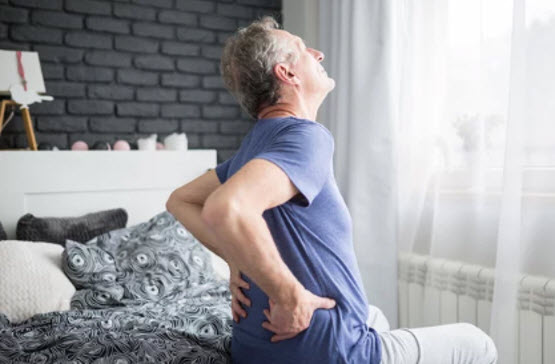
Lower Back Pain
Lower back pain is a common condition that affects millions of people worldwide. It refers to discomfort or pain in the lower part of the back, specifically in the area between the ribcage and the pelvis. This condition can range from mild to severe and can be acute or chronic.
Lower back pain, also known as lumbago, can have a significant impact on a person’s quality of life, making it difficult to perform daily activities and affecting their overall well-being. It is a leading cause of disability and is one of the most common reasons for seeking medical attention.
The symptoms of lower back pain can vary from person to person but commonly include a dull, aching sensation, stiffness, and limited range of motion. In some cases, the pain may radiate down the legs, causing additional discomfort and difficulty in walking or standing for prolonged periods.
Lower back pain can be classified into different stages based on the duration and severity of the symptoms. Acute lower back pain typically lasts for a few days to a few weeks, while chronic lower back pain persists for more than three months. Recurrent episodes of lower back pain may also occur, where the pain comes and goes periodically.
Understanding the causes and risk factors associated with lower back pain is crucial in addressing and managing this condition effectively. By identifying the underlying factors contributing to the pain, healthcare professionals can develop personalized treatment plans to alleviate symptoms and promote long-term relief.
Symptoms & Different Stages of Lower Back Pain
Lower back pain can manifest in various ways, and the severity of symptoms can vary from person to person. Understanding the different stages of lower back pain can help individuals identify the condition and seek appropriate treatment for spinal decompression.
- Stage 1: Mild discomfort or aching sensation in the lower back region. The pain may come and go, and individuals may experience occasional stiffness.
- Stage 2: The pain becomes more persistent and may radiate to the buttocks or thighs. Daily activities such as bending, lifting, or sitting for extended periods can exacerbate the pain.
- Stage 3: The pain intensifies and may spread to the legs, causing numbness or tingling sensations. Individuals may find it challenging to perform regular tasks and may experience difficulty standing or walking for prolonged periods.
- Stage 4: This is the most severe stage of lower back pain. The pain becomes excruciating and debilitating, significantly impacting an individual’s quality of life. Simple movements like getting out of bed or walking short distances can trigger intense pain.
It is important to note that the progression of lower back pain can vary from person to person. Some individuals may experience a gradual worsening of symptoms, while others may have sudden onset severe pain.
If you are experiencing lower back pain, it is crucial to pay attention to certain warning signs that may indicate a more serious condition. These include:
- Severe pain that does not improve with rest or over-the-counter pain medications
- Pain accompanied by weakness, numbness, or tingling in the legs
- Loss of bladder or bowel control
- Unexplained weight loss
- Fever or chills
If you experience any of these symptoms, it is recommended to seek immediate medical attention, as they may indicate underlying medical conditions that require prompt diagnosis and treatment.

Most Common Causes of Lower Back Pain
Lower back pain can be caused by a variety of factors, ranging from lifestyle choices to medical conditions. Understanding the most common causes can help individuals identify potential triggers and take appropriate preventive measures. Here are some typical causes of lower back pain:
- Poor posture: Sitting or standing for extended periods with improper posture can strain the muscles and ligaments in the lower back, leading to pain.
- Muscle strain: Overuse, excessive lifting, or sudden movements can cause muscle strains in the lower back, resulting in pain and discomfort.
- Herniated discs: When the soft, gel-like center of a spinal disc protrudes through a tear in the outer layer, it can put pressure on nearby nerves, causing lower back pain.
- Spinal stenosis: This condition occurs when the spinal canal narrows, putting pressure on the spinal cord and nerves. It commonly affects older adults and can lead to lower back pain.
- Arthritis: Osteoarthritis and rheumatoid arthritis can affect the spine, causing inflammation and pain in the lower back.
- Sedentary lifestyle: Lack of physical activity weakens the muscles that support the spine, making individuals more susceptible to lower back pain.
- Obesity: Excess weight puts additional strain on the lower back, increasing the risk of pain and discomfort.
- Injury or trauma: Accidents, falls, or sports-related injuries can damage the structures in the lower back, leading to pain.
It’s important to note that these are just some of the most common causes of lower back pain, and individual experiences may vary. Consulting with a healthcare professional can help determine the specific cause of lower back pain and guide appropriate treatment options.
How bad can lower back pain be if left untreated?
- Chronic pain: If left untreated, lower back pain can become a chronic condition, causing persistent discomfort and limiting daily activities.
- Reduced mobility: As the condition progresses, lower back pain can lead to decreased range of motion and difficulty performing simple tasks such as bending, lifting, or even walking.
- Impaired quality of life: The constant presence of pain can significantly impact a person’s overall quality of life, affecting their ability to work, engage in hobbies, or enjoy social activities.
- Psychological effects: Dealing with chronic pain can take a toll on mental health, leading to feelings of frustration, anxiety, and even depression.
- Increased risk of disability: Severe cases of untreated lower back pain can result in long-term disability, making it challenging to maintain employment or participate in daily routines.
- Complications in other areas: Lower back pain can also lead to compensatory movements and postures, which can cause strain and pain in other parts of the body, such as the hips, knees, or neck.
- Sleep disturbances: Persistent pain can disrupt sleep patterns, leading to fatigue and further exacerbating the physical and emotional toll of the condition.
It is crucial to address lower back pain early on to prevent it from progressing and causing further complications. Seeking appropriate treatment, such as chiropractic care, can help alleviate pain, improve mobility, and enhance overall well-being.
Chiropractic for Lower Back Pain
Chiropractic care offers a holistic approach to managing lower back pain, focusing on the root cause of the condition rather than just alleviating the symptoms. Through various techniques and therapies, chiropractors aim to restore proper alignment and function to the spine, promoting natural healing and pain relief. Here are some ways in which chiropractic can help with lower back pain:
- Spinal adjustments: Chiropractors use manual manipulation techniques to realign the spine, reducing pressure on the affected nerves and relieving pain. By restoring proper spinal alignment, chiropractic adjustments can improve mobility and function in the lower back.
- Soft tissue therapy: In addition to spinal adjustments, chiropractors may use soft tissue therapies such as massage, myofascial release, and trigger point therapy to relax tense muscles, reduce inflammation, and improve blood circulation in the lower back area.
- Exercise and rehabilitation: Chiropractors often prescribe specific exercises and stretches to strengthen the muscles supporting the lower back and improve flexibility. These exercises can help prevent future episodes of lower back pain and promote long-term recovery.
- Ergonomic and lifestyle advice: Chiropractors guide proper posture, ergonomics, and lifestyle modifications to reduce the risk of aggravating lower back pain. This may include recommendations for workplace ergonomics, lifting techniques, and exercises to incorporate into daily routines.
- Complementary therapies: Some chiropractors may incorporate complementary therapies such as acupuncture, heat therapy, or cold therapy to further enhance pain relief and promote healing in the lower back.
It is important to note that Chiropractic treatment for back pain is a non-invasive and drug-free approach to managing lower back pain. By addressing the condition’s underlying causes and promoting natural healing, chiropractic offers a safe and effective alternative to traditional medical treatments. However, consulting with a qualified chiropractor is always advisable to determine the most suitable treatment plan for your specific condition.

Self-Help & Relief for Lower Back Pain
- Exercise regularly: Engaging in low-impact exercises such as walking, swimming, or cycling can help strengthen the muscles supporting the lower back and improve flexibility. It is important to start slowly and gradually increase the intensity and duration of the exercises.
- Practice good posture: Maintaining proper posture throughout the day can alleviate strain on the lower back. Remember to sit up straight, avoid slouching, and use ergonomic chairs or cushions for added support.
- Apply heat or cold therapy: Applying a heating pad or taking a warm bath can help relax the muscles and reduce pain. Alternatively, using an ice pack wrapped in a towel for about 20 minutes can help reduce inflammation and numb the area.
- Try over-the-counter pain relievers: Nonsteroidal anti-inflammatory drugs (NSAIDs) like ibuprofen or acetaminophen can temporarily relieve lower back pain. However, it is important to follow the recommended dosage and consult a healthcare professional if the pain persists.
- Use proper lifting techniques: When lifting heavy objects, remember to bend at the knees and use the leg muscles instead of straining the back. Additionally, avoid twisting the body while lifting and use assistive devices if necessary.
- Practice stress management techniques: Chronic stress can exacerbate lower back pain. Engaging in relaxation techniques such as deep breathing exercises, meditation, or yoga can help reduce stress levels and alleviate pain.
- Improve sleep posture: Sleeping on a firm mattress and using a supportive pillow can help maintain proper spinal alignment while sleeping. Sleeping on the side or back rather than on the stomach is recommended to avoid straining the lower back.
While these self-help methods can provide temporary relief for lower back pain, it is important to remember that they may not address the underlying cause of the condition. If the pain persists or worsens, it is advisable to seek professional help from a chiropractor or healthcare provider. They can assess the condition, provide a proper diagnosis, and offer personalized treatment options to address the root cause of the pain.
When to Seek Medical Attention for Lower Back Pain
If you are experiencing lower back pain, it is important to understand that living with pain is not something you should endure. Seeking medical attention can help alleviate your discomfort and improve your overall quality of life. Here are some signs that indicate it is time to consult a healthcare professional:
- Severe pain: If your lower back pain is intense and debilitating, it is crucial to seek immediate medical attention. Severe pain can be indicative of a serious underlying condition that requires prompt treatment.
- Pain that persists for more than a few weeks: If your lower back pain persists for more than a few weeks despite self-care measures, it is advisable to consult a healthcare professional. Chronic pain may be a sign of an underlying issue that requires further evaluation and treatment.
- Pain that radiates down your leg: If your lower back pain is accompanied by pain, numbness, or tingling that radiates down your leg, it could be a sign of a compressed nerve or herniated disc. Seeking medical attention can help diagnose the cause and prevent further complications.
- Loss of bladder or bowel control: If you experience a loss of bladder or bowel control along with lower back pain, it could be a sign of a serious condition such as cauda equina syndrome. This condition requires immediate medical intervention.
Remember, it is always better to err on the side of caution regarding your health. Consulting a healthcare professional can provide you with an accurate diagnosis and appropriate treatment options for your lower back pain. Don’t hesitate to reach out for help and take the necessary steps towards a pain-free life.

Dr. Jenny Li is America trained chiropractor who specialises in sports injury, sports performance, and spinal health. She graduated from Palmer College of Chiropractic in United States, upon completion of the her post graduate program she practiced in Hong Kong and currently is practicing in Singapore.

